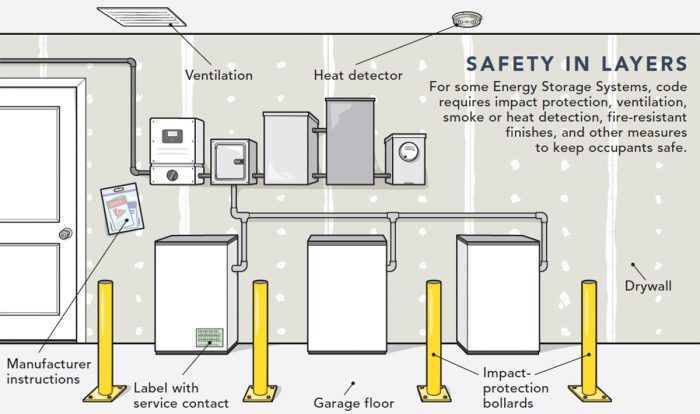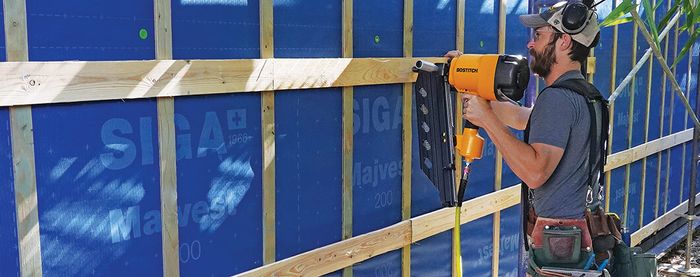Rules for Storing Your Own Electricity
With an increase in the popularity of electric vehicles and solar panels, new building code requirements for safely housing systems to store excess energy have cropped up.

Synopsis: Code expert Glenn Mathewson describes the recent advancements in code requirements for Energy Storage Systems, or ESS. A number of updates to the energy-storage provisions appear in a section in the 2021 International Residential Code, explaining that ESS must comply with certain installation provisions that include capacity restrictions, limitations on where the ESS can be installed, and other requirements for impact protection, ventilation, heat detection, and more.
Codes don’t cover everything, and they don’t typically address something new until it starts moving from niche to normal. Sometimes the public needs a little help when subjects aren’t being addressed in the code. That’s where the Building Code Action Committee (BCAC) steps in. The International Code Council created the BCAC in 2014 to pursue opportunities to enhance the I-Codes, on which many of the legally adopted building codes are based. These are updated every three years in a process open to public participation.
In 2016, this committee submitted a proposal for a new section in the International Residential Code (IRC) titled “Stationary Storage Battery Systems,” with just a few basic provisions to offer some guidance for the public’s growing interest in home energy storage (Section R327 in the 2018 IRC). Home solar installations had been on the rise for some time, but energy storage had been missing from the code. Because solar panels only produce when the sun is shining, and not every utility pays homeowners for the energy their panels put into the grid, energy storage is the only way to make solar worth the investment for many homeowners. At the same time, electric cars started gaining popularity.
Three years later, at the hearings to create the 2021 edition of the IRC, there was no longer worry about the public participating in codes for battery storage. From car manufacturers to UL (formerly known as Underwriters Laboratories), there were folks involved.
There were six new proposals for updates to the IRC’s battery-storage provisions, and most of them made it into the code in one form or another. One suggested that commissioning procedures be added and recommended a change in terminology from “Stationary Battery Storage Systems” to “Energy Storage Systems,” or ESS. Modifications during the hearing lightened up the commissioning suggestion to simply require that installation, operation, and maintenance instructions be placed near the equipment, similar to what’s required for a furnace or water heater. Additionally, a label with the contact information of a qualified service provider is now required on the equipment. That’s kind of wild if you think about it: the code is mandating the marketing of private businesses in homes. This stuff is technical and specialized, but it’s still a little strange.
Both of those proposals passed during the first hearing. Others took a little more effort. The hearing records show that most proponents of the proposals that didn’t pass the first go-round came together and offered a public comment modification that incorporated most of the various concerns and ideas in the other proposals. With such broad collaboration, it’s no surprise their modification made it into the 2021 IRC.
The updated section, R328 in the 2021 IRC, opens with a simple statement that ESS must comply with this whole section, but it then excepts two groups of ESS from those requirements. One is systems with capacities less than 1kwh; the other is systems that are “Listed and labeled in accordance with UL 9540 and marked ‘For use in residential dwelling units’ where installed in accordance with the manufacturer’s instructions and NFPA 70.”
NFPA 70 is the National Electrical Code, and its provisions, along with manufacturer installation instructions, are always required. Later in this section you find that all ESS have to be “listed and labeled” in accordance with UL 9540. So, the “For use in residential dwelling units” mark is something additional and specifically for ESS that can be inside the living-type portions of the dwelling. As may be expected, this part of the 2021 provisions were from a proposal from UL.
In 2019, the year the 2021 IRC provisions were being developed, UL was also updating standards. UL 9540, the referenced test standard for ESS, includes a section for a large-scale fire test in according with UL 9540A, also updated. The 9540A standard provides a fire test that allows manufacturers to prove their system’s performance and gain approval for less-restrictive installation requirements than what’s published in the codes. Under the International Fire Code and the new NFPA 855 standard for ESS systems, when these systems are proven not to spread fire to adjacent units or not to spread fire beyond the room, for example, they are allowed reduced clearances, separations, and protections, and the IRC references this option as well.
There are, of course, many more details in these two codes. However, specifically under the 2021 IRC, as the latest code on the subject, the additional 9540A testing provides a specific “Cell Level Test” to earn the “mark” for indoor use in dwellings. If the unit passes and it earns the mark, the remaining provisions in Section 328 do not apply, but the manufacturer instructions must be followed.
Without the mark for interior residential use, you have to follow the rest of R328 in addition to manufacturer instructions for units larger than 1kwh. Among the restrictions is capacity. Individual units are limited to a maximum rating of 20kwh. Where multiple units are used, the aggregate maximum ratings run between 40kwh and 80kwh depending on where they are located, and the units must be separated by at least 3 ft. However, there are exceptions here. The IRC allows you to exceed these kilowatt-hour ratings and space units closer together if they’re tested and installed under provisions of the fire code.
“Think of it for a moment: The building code requires you to read your car manual.“
The IRC also limits where you can install ESS without the special indoor-use mark to specific locations with specific protections. They can be located in an attached garage, provided they’re separated from the rest of the dwelling with drywall, as is required of all attached garages (R302.6). Older attached garages lacking drywall according to current codes will require the upgrade if an ESS is installed within. They can also go in detached garages or other accessory structures with no additional fire protections required. They would still need protection from vehicular impact, though, just as they do in attached garages or outside near driving surfaces.
Indoors, they can be installed in enclosed utility closets, basements, and storage or utility spaces, with finished or noncombustible walls and ceilings. In wood-frame construction, the walls and ceilings must be covered in 5/8-in. type X drywall. When any room contains an ESS, it cannot have an opening of any kind directly into a sleeping room.
For the indoor spaces and attached garages, a smoke alarm must be installed according to Section R314, to include all the power, interconnection, and listing requirements in that section. If an installation location is in violation of the listing and installation instructions of a smoke alarm, then a heat detector must be installed. Remember, though, this is only for units without the “mark.”
One of the original provisions from the 2018 code is retained with little change in the 2021 edition: the need for ventilation. However, this is dependent on the technology used in the ESS. Only systems that produce hydrogen or other flammable gasses are required ventilation in accordance with Section M1307.4 in the IRC mechanical chapters.
The IRC also allows ESS installations outdoors, and similar to the separation between multiple units, they must also be 3 ft. away from doors or windows opening into the dwelling.
All of the above is interesting stuff, but what if you don’t have solar panels, and do own an electric car? Under Section R328.11, an occupant’s car is permitted to temporarily power the dwelling, as long as it’s done in accordance with the vehicle manufacturer’s installation instructions and the electrical code. Think of it for a moment: the building code requires you to read your car manual. That’s another provision that’s pretty outside of the norm for building codes.
And when that electric car isn’t running so well anymore, there’s an exception that allows you to repurpose its batteries in an unlisted ESS. This is the one exception to the code’s requirement that ESS be listed according to UL 9540. You can reuse electrical car battery systems in an unlisted ESS and keep them in a shed at least 5 ft. from your house or property line. This is a great example of how the code responds to risk. The more risk, the more tests, proof, standards, and protection required. When risk is reduced, go ahead and reuse and repurpose.
Glenn Mathewson is a consultant and educator with buildingcodecollege.com. Special thanks to the ICC, NFPA, and UL for providing free online viewing of their important safety standards.
Drawing: Kate Francis.
From Fine Homebuilding #300
RELATED LINKS






View Comments
We have just started looking into setting up electrical storage solutions and you have definitely hit the nail on the head with this article thanks a lot fr the info!
Thanks From MD Electrical & Data, https://www.mdelectricaldata.com/